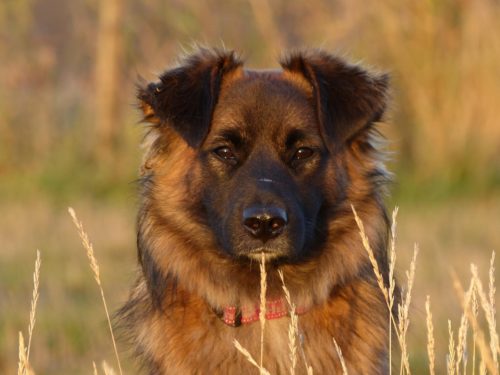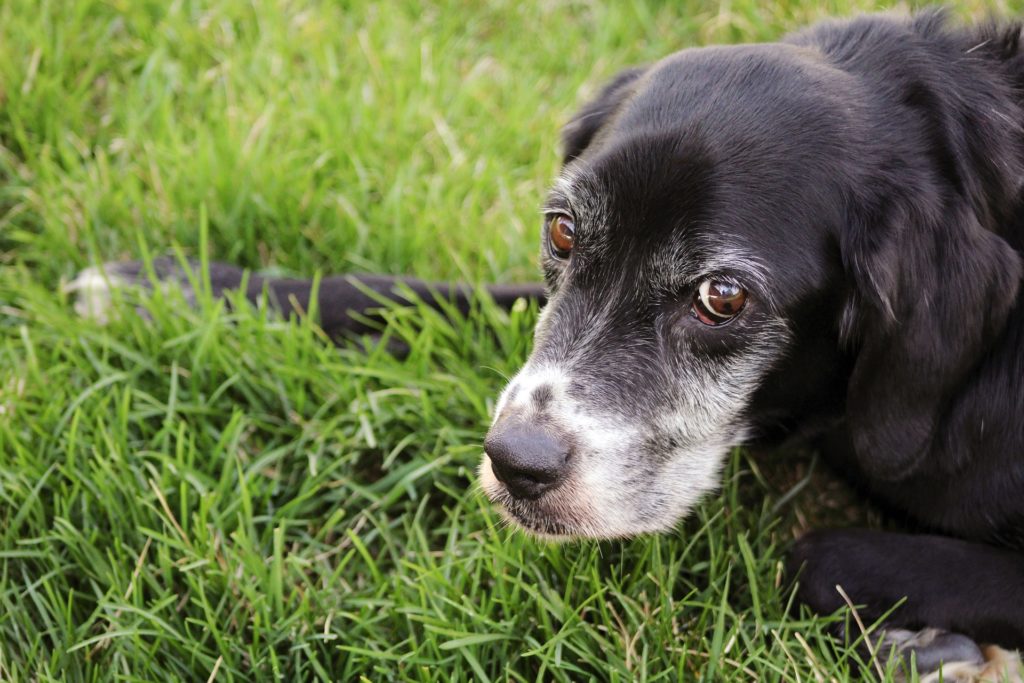Has your dog been acting extra tired lately? Does it seem to hurt your dog when he walks? When you go to pet him, does he pull away, seemingly in pain? These could be signs your dog is suffering from lupus.
What is Lupus in Dogs?
Lupus in dogs is an autoimmune disease that is genetic and can affect various parts of a dog’s body. Discoid lupus erythematosus (DLE), which is commonly referred to as “collie nose,” is known to affect a dog’s face, specifically the bridge of the nose, lips, and ears. In some cases, this type of lupus will affect a dog’s feet and genitalia as well. This disease typically develops in summer months and direct sunlight makes symptoms, such as scaly skin and sores, worse.
System lupus erythematosus (SLE) is the more serious of the two types of lupus in dogs. It affects the skin, but also organs like the heart, liver, and kidneys. Depending on the severity of the disease, symptoms can range from painful joints to lameness and lethargy in dogs. When your pet experiences any kind of autoimmune disease, it’s a result of the body essentially attacking itself, which is painful, uncomfortable, and in some cases, fatal.
Make sure you are monitoring changes to your dog’s health and behavior and looking for common symptoms of lupus, as well as other potential diseases. Several health conditions may have similar symptoms. To know for sure what’s wrong with your pet, you’ll need to get a veterinarian’s diagnosis.
Signs and Symptoms of Lupus in Dogs

Prior to scheduling an appointment with a veterinarian, you’ll want to track what kind of symptoms your dog has been experiencing. There is a difference in the two types of lupus, both of which require veterinary attention in order to receive a diagnosis and treatment. If you begin to notice symptoms in your pet, report what your dog is experiencing and also, how often it’s occurring.
Common symptoms of DLE include:
- Extreme redness
- Skin sores
- Cracking skin, loss of pigment, and/or ringworm on the nose
- Itchiness
Breeds predisposed to this type of lupus include German Shepherds, Siberian Huskies, Alaskan Malamutes, Chow Chows, Shetland Sheepdogs, German Shorthaired Pointers, and Brittany Spaniels. On average, dogs over 6 years of age develop lupus, but the disease can happen at any time. Any types of sores can also lead to bacterial infection, so you’ll want to get it checked out as soon as possible.
Common symptoms of (SLE) include:
- Joint and muscle pain
- Stiffness or lameness in the legs
- Lethargy
- Loss of appetite
- Hair loss
- Swollen lymph nodes
- Seizures
Shetland Sheepdogs, Old English Sheepdogs, Afghan Hounds, Beagles, Collies, Irish Setters, and Poodles pose a higher risk of developing SLE. Whatever kind of dog you have, it’s always a good idea to have a general history of the types of diseases that are more common for his breed. This will make you more alert to symptoms and signs of disease or other health conditions.
What Causes Lupus in Dogs?
Interestingly enough, the word “lupus” comes from the Latin word for wolf, since the disease was first thought to be a result of a wolf’s bite. This is not a cause of the disease, but no singular, definitive answer has been given. Some believe it’s an inherited condition, while other factors like increased sun exposure, poor reactions to medication, and viral infections could all contribute to lupus in dogs.
Since no one knows for sure what is responsible for the disease, preventable treatment generally requires a healthy lifestyle and consistent activity level for dogs. Beyond that, it’s hard to tell if or when the disease will affect your dog.
Diagnosing Lupus in Dogs
The symptoms of both types of lupus in dogs can make it difficult for it to be diagnosed because they are representative of other types of autoimmune diseases, too. For DLE, a diagnosis can be made after completing a checkup and performing a skin biopsy to get a clearer picture of what the symptoms mean.
SLE symptoms are similar to those found in cases of kidney disease and cancer in dogs. Your veterinarian can run blood tests to cancel out other types of diseases and distinguish lupus as the diagnosis. One way is to perform an antinuclear antibodies (ANA) test. If your dog tests positive for this, it can be the differentiating factor between lupus and other diseases.
Just because your dog exhibits signs of an autoimmune disease, don’t assume the worst. It can be a range of health conditions, many of which are treatable.
How to Treat Lupus in Dogs
Both types of lupus can be fatal for dogs without treatment. Neither is a curable disease, but rather, lupus requires a shift in lifestyle to actively minimize symptoms, discomfort, and pain in dogs. Treatment options for SLE may include administering corticosteroids, such as prednisone, or antibiotics if secondary infections are found.
Also, it’s best to limit a dog’s exposure to sunlight, as this only aggravates symptoms. Protect your dog by keeping him out of the sun as much as possible, especially during the highest peaks of the day. Chemotherapy might also be recommended to help treat pain and suppress abnormal responses of the immune system.

DLE, the less severe of the two types of lupus, is easier to treat, but still there is no cure. In order to reduce inflammation and control skin sores, topical corticosteroids are the typical recommendation. Other treatment like prednisone and other antibiotics are also part of the treatment plan to stave off other infections and inflammation in dogs.
In addition to these more traditional methods of treatment, you may turn to alternative options to supplement care. These may include massage therapy, acupuncture, and dietary changes for your dogs. The goal post-diagnosis is to create a healthy, comfortable environment for your dog and ensure a daily lifestyle that reflects healthy choices to keep the body’s systems running strongly. Many pet owners also choose to add vitamin E and Omega 3 and Omega 6 fatty acids to their dog’s diet to help alleviate symptoms and pain. An organic, plant-based diet has the kind of nutrients you want for your dog when they’re sick or facing disease.
Not sure of which route to take? Ask your veterinarian for recommendations for holistic treatment either as an alternative to medication or a supplement to help prevent symptoms from recurring.
Lupus in Dogs FAQs
If your dog has been healthy most of his life, lupus as a diagnosis can seem overwhelming. Dog owners never like to think of their pets suffering. But as your dog ages, it’s more common for him to experience setbacks to his health. Here are a few frequently asked questions about lupus in dogs that can help serve as a guide as you learn more about the disease.
Is my dog at risk for lupus?
DLE is the second most common type of autoimmune disease to affect the skin, second behind pemphigus foliaceus. The likelihood of your dog contracting the disease is dependent on several factors, such as age, breed, how much sun exposure he has on a daily basis, as well as his overall health. DLE affects dogs of all breeds and both sexes.
My dog’s hair has been falling out in clumps, does he have lupus?
Hair loss or alopecia is only one of the many symptoms experienced by dogs with lupus. You would need to take him to receive blood work at your veterinary clinic to diagnose his condition, as hair loss in dogs could be the result of other diseases or just additional stress.
How can I ensure my dog is getting enough vitamin E?
Choose organic foods for your pet that are free from preservatives and high in vitamins and nutrients. Foods high in vitamin E include eggs, halibut, kidneys, livers, flaxseed, alfalfa, and dandelion to name a few. Switching your dog’s diet can contribute to his overall wellness plan, in addition to help alleviate symptoms of lupus.
Is lupus in dogs curable?
There is no cure for lupus in dogs, just as there is no central cause. However, treatment is readily available to help keep symptoms under control and your dog thriving throughout his life. The sooner your receive an official diagnosis, the sooner you can start on the right treatment path for your pet.

How can I tell if my dog is in pain?
Depending on your pet’s disposition, it may not be immediately obvious when he is in pain. If he favors one leg over another, if he seems to have several spots that are tender to the touch, or if you’ve noticed him lying down and sleeping more often than normal, your dog may be in pain.
Since you can’t ask him to gauge the level of pain, it’s better to err on the side of safety and take him to the veterinarian. Make sure to provide any information regarding other symptoms you may have noticed. Anything that gives more context to the situation, the more helpful it will be to the veterinary staff.
What should I do if my dog has been diagnosed with lupus?
The veterinarian will make recommendations for treatment. As with any autoimmune disease, there may be days when symptoms are barely noticeable and other days where they flare up. Your dog will have good days but he also will likely have some bad ones, too. Keep him as comfortable as possible. Also, maintain a regular routine. It’ll make any odd changes in behavior more easily identifiable. Plus, it’ll be better for your pet’s body to adjust if everything is as consistent as possible.
My dog doesn’t seem to be responding to medication very well – what should I do?
First, never discontinue prescribed medication for your pet unless approved by the veterinarian. If your dog is having an adverse reaction to the medication or his symptoms do not seem to be improving, schedule an appointment for a checkup. It may mean your dog needs a different dosage or his medicine needs to be switched.
When the veterinarian prescribes medication, he or she will alert you to any kind of side effects to look out for. The first few weeks of administering the medication will be the testing phase. Note any changes in behavior or negative reactions to the medication. If conditions worsen or new one appear, call the emergency clinic.
What kind of information should I provide the dog sitter?
Whenever your dog is in the care of others for an extended period of time, give them as much relevant health information as possible. This includes disclosing a lupus diagnosis, if your dog is dealing with the disease. Also, list medications your dog is taking and the dosage amount. Mention any allergies, food aversions, or dietary restrictions. If it is difficult for your dog to take his medication, indicate that as well, in addition to solutions to make it a success for the caregiver.

Caring for Your Pet After a Lupus Diagnosis
Caring for a pet is a big deal. Caring for a pet with lupus, even bigger. You know your dog the best and can tell if he’s in pain. Although in many cases, it may be caused by something temporary, if it persists, don’t hesitate scheduling an appointment with the veterinarian.
As your dog ages, there likely will be symptoms or ailments that may mysteriously pop up, all which should be addressed at your dog’s checkups. Your veterinarian can run some preliminary tests, if necessary, and further evaluate the situation. This helps you catch illness or other health conditions before they become too severe.
Over time, your pet may move slower and not be as active as before. Caring for a dog with lupus will take an adjustment period. Comfort for your pet is key. Give your dog what he needs to thrive and be as healthy as possible. This involves regulating his diet, exercise habits, and activity levels. Follow the recommendations given to you by your veterinarian. In addition, set up a special, comfortable space where he can relax without too much distraction.
If your dog has been diagnosed with lupus, attentive care and support are more important now than ever. And being informed and aware of the potential warning signs of the disease is a good place to start.




